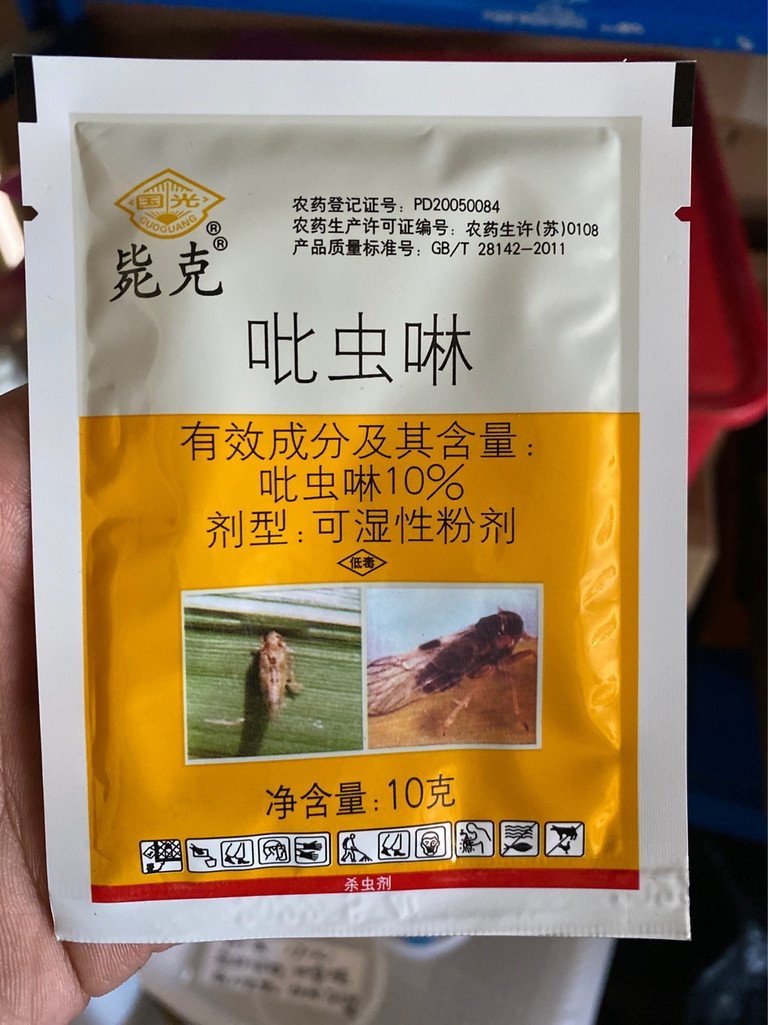吡虫啉Imidacloprid
Imidacloprid is a nitromethylene class systemic insecticide that acts on the acetylcholine receptor of nicotine receptors, disrupting the pest's nervous system and causing a breakdown in chemical signal transmission, without cross-resistance issues. It is used to prevent and control piercing-sucking insect pests and their resistant strains. Imidacloprid is a new generation chlorinated nicotine insecticide, characterized by its broad-spectrum, high efficiency, low toxicity, low residue, and resistance prevention in pests. It has multiple effects, including contact, stomach poison, and systemic action. After pests come into contact with the agent, their central nervous system's normal conduction is blocked, leading to paralysis and death. It shows fast action, with high protective effects within a day after application, and a residual period of about 25 days. The effectiveness is positively correlated with temperature; higher temperatures result in better insecticidal effects. It is primarily used to prevent and control piercing-sucking insect pests. Imidacloprid is used mainly to control piercing-sucking insect pests, and it can be alternated with thiamethoxam based on temperature (use imidacloprid at high temperatures and thiamethoxam at low temperatures). It is effective against pests such as aphids, leafhoppers, whiteflies, planthoppers, and thrips. It is also effective against certain pests of Coleoptera, Diptera, and Lepidoptera, such as rice weevils, rice stink bugs, and rice leaf folders. However, it is ineffective against nematodes and spider mites. It can be used on crops such as rice, wheat, corn, cotton, potatoes, vegetables, sugar beets, fruit trees, and other crops. Due to its excellent systemic properties, it is particularly suitable for seed treatment and granular application. Generally, 3-10 grams of active ingredient per mu is used, diluted with water for spraying or seed coating. The safety interval is 20 days. During application, attention should be paid to protection to prevent skin contact and inhalation of powder or liquid. Exposed areas should be washed promptly with clean water after use. It should not be mixed with alkaline pesticides. It is not advisable to spray under strong sunlight to avoid reducing efficacy.
Imidacloprid is a nitromethylene class systemic insecticide that acts on the acetylcholine receptor of nicotine receptors, disrupting the pest's nervous system and causing a breakdown in chemical signal transmission, without cross-resistance issues. It is used to prevent and control piercing-sucking insect pests and their resistant strains. Imidacloprid is a new generation chlorinated nicotine insecticide, characterized by its broad-spectrum, high efficiency, low toxicity, low residue, and resistance prevention in pests. It has multiple effects, including contact, stomach poison, and systemic action. After pests come into contact with the agent, their central nervous system's normal conduction is blocked, leading to paralysis and death. It shows fast action, with high protective effects within a day after application, and a residual period of about 25 days. The effectiveness is positively correlated with temperature; higher temperatures result in better insecticidal effects. It is primarily used to prevent and control piercing-sucking insect pests. Imidacloprid is used mainly to control piercing-sucking insect pests, and it can be alternated with thiamethoxam based on temperature (use imidacloprid at high temperatures and thiamethoxam at low temperatures). It is effective against pests such as aphids, leafhoppers, whiteflies, planthoppers, and thrips. It is also effective against certain pests of Coleoptera, Diptera, and Lepidoptera, such as rice weevils, rice stink bugs, and rice leaf folders. However, it is ineffective against nematodes and spider mites. It can be used on crops such as rice, wheat, corn, cotton, potatoes, vegetables, sugar beets, fruit trees, and other crops. Due to its excellent systemic properties, it is particularly suitable for seed treatment and granular application. Generally, 3-10 grams of active ingredient per mu is used, diluted with water for spraying or seed coating. The safety interval is 20 days. During application, attention should be paid to protection to prevent skin contact and inhalation of powder or liquid. Exposed areas should be washed promptly with clean water after use. It should not be mixed with alkaline pesticides. It is not advisable to spray under strong sunlight to avoid reducing efficacy.
Imidacloprid is a nitromethylene class systemic insecticide that acts on the acetylcholine receptor of nicotine receptors, disrupting the pest's nervous system and causing a breakdown in chemical signal transmission, without cross-resistance issues. It is used to prevent and control piercing-sucking insect pests and their resistant strains. Imidacloprid is a new generation chlorinated nicotine insecticide, characterized by its broad-spectrum, high efficiency, low toxicity, low residue, and resistance prevention in pests. It has multiple effects, including contact, stomach poison, and systemic action. After pests come into contact with the agent, their central nervous system's normal conduction is blocked, leading to paralysis and death. It shows fast action, with high protective effects within a day after application, and a residual period of about 25 days. The effectiveness is positively correlated with temperature; higher temperatures result in better insecticidal effects. It is primarily used to prevent and control piercing-sucking insect pests. Imidacloprid is used mainly to control piercing-sucking insect pests, and it can be alternated with thiamethoxam based on temperature (use imidacloprid at high temperatures and thiamethoxam at low temperatures). It is effective against pests such as aphids, leafhoppers, whiteflies, planthoppers, and thrips. It is also effective against certain pests of Coleoptera, Diptera, and Lepidoptera, such as rice weevils, rice stink bugs, and rice leaf folders. However, it is ineffective against nematodes and spider mites. It can be used on crops such as rice, wheat, corn, cotton, potatoes, vegetables, sugar beets, fruit trees, and other crops. Due to its excellent systemic properties, it is particularly suitable for seed treatment and granular application. Generally, 3-10 grams of active ingredient per mu is used, diluted with water for spraying or seed coating. The safety interval is 20 days. During application, attention should be paid to protection to prevent skin contact and inhalation of powder or liquid. Exposed areas should be washed promptly with clean water after use. It should not be mixed with alkaline pesticides. It is not advisable to spray under strong sunlight to avoid reducing efficacy.
10g
